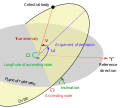is a list of types of gravitational orbit classified by various characteristics. The following is a list of types of orbits: Galactocentric orbit: An orbit...
31 KB (3,455 words) - 19:37, 27 October 2024
the orbits of Mars and Jupiter Ceres, a dwarf planet Pallas Vesta Hygiea Asteroids number in the hundreds of thousands. For longer lists, see list of exceptional...
6 KB (486 words) - 20:16, 24 October 2024
also follows an elliptic orbit. Examples of elliptic orbits include Hohmann transfer orbits, Molniya orbits, and tundra orbits. Under standard assumptions...
19 KB (2,744 words) - 21:11, 2 October 2024
(that is, from the approximate direction of the star Polaris) the Moon orbits Earth anticlockwise and Earth orbits the Sun anticlockwise, and the Moon and...
37 KB (4,642 words) - 12:31, 11 October 2024
only a few orbital trajectories possible for indefinite frozen orbits. These would be useful for long-term stays in LLO. Most lunar low orbits below 100...
16 KB (1,721 words) - 00:05, 26 September 2024
A low Earth orbit (LEO) is an orbit around Earth with a period of 128 minutes or less (making at least 11.25 orbits per day) and an eccentricity less...
19 KB (2,179 words) - 17:10, 20 October 2024
graveyard orbit, also called a junk orbit or disposal orbit, is an orbit that lies away from common operational orbits. One significant graveyard orbit is a...
8 KB (1,003 words) - 02:20, 12 October 2024
Idealised orbits meeting these rules are known as Kepler orbits. Isaac Newton demonstrated that Kepler's laws were derivable from his theory of gravitation...
57 KB (8,167 words) - 12:48, 16 October 2024
whole number of orbits per day. Assuming a circular orbit, this comes down to between 7 and 16 orbits per day, as doing less than 7 orbits would require...
14 KB (1,657 words) - 07:15, 21 October 2024
Earth orbit, where geostationary satellites are and where after their end of use they are parked in similar orbits, so-called graveyard orbits. Atmospheric...
10 KB (1,037 words) - 23:27, 10 October 2024
system. Continuous "families" of both northern and southern halo orbits exist at each Lagrange point. Because halo orbits tend to be unstable, station-keeping...
11 KB (1,104 words) - 16:53, 22 April 2024
values, Mars' orbital altitude is equal to 17039 km. Spaceflight portal List of orbits List of satellites in geosynchronous orbit Orbital station-keeping...
49 KB (4,861 words) - 12:14, 29 October 2024
probes and pieces of debris. The moons of planets in the Solar System, by contrast, are not in heliocentric orbits, as they orbit their respective planet...
4 KB (383 words) - 11:49, 12 July 2024
around the Sun—an orbital maneuver is called a deep-space maneuver (DSM).[not verified in body] Transfer orbits are usually elliptical orbits that allow spacecraft...
41 KB (5,821 words) - 22:06, 8 September 2024
Earth orbits the Sun at an average distance of 149.60 million km (92.96 million mi), or 8.317 light-minutes, in a counterclockwise direction as viewed...
17 KB (1,874 words) - 04:15, 29 October 2024
Geosynchronous Orbit NASA – Planetary Orbits Science Presse data on Geosynchronous Orbits (including historical data and launch statistics) Orbital Mechanics...
33 KB (3,183 words) - 15:36, 22 August 2024
astronautics, the Hohmann transfer orbit (/ˈhoʊmən/) is an orbital maneuver used to transfer a spacecraft between two orbits of different altitudes around a...
27 KB (3,626 words) - 18:17, 19 September 2024
100-minute orbit. List of orbits Molniya orbit Tundra orbit Vandenberg Air Force Base, a major United States launch location for polar orbits "ESA - Types of Orbits"...
3 KB (416 words) - 15:33, 8 January 2024
Canada. While satellites in Molniya orbits require considerably less launch energy than those in geostationary orbits (especially launching from high latitudes)...
28 KB (3,119 words) - 03:30, 2 October 2024
(near-circular orbits) are very close to their star and are tidally-locked to the star. All eight planets in the Solar System have near-circular orbits. The exoplanets...
25 KB (2,767 words) - 19:34, 21 October 2024
i} is the orbital inclination, and T {\displaystyle T} is the orbital period. List of orbits Orbital inclination Non-inclined orbit Basics of the Geostationary...
3 KB (338 words) - 20:20, 12 June 2024
the orbital speed of an astronomical body or object (e.g. planet, moon, artificial satellite, spacecraft, or star) is the speed at which it orbits around...
11 KB (1,410 words) - 01:29, 7 October 2024
Halo orbits also include components perpendicular to the plane, but they are periodic, while Lissajous orbits are usually not. In practice, any orbits around...
8 KB (766 words) - 12:21, 22 August 2024
satellites. Captured bodies on distant orbits vary widely in their inclinations, while captured bodies in relatively close orbits tend to have low inclinations...
11 KB (1,465 words) - 15:40, 23 October 2023
mass. In the special case of perfectly circular orbits, the semimajor axis a is equal to the radius of the orbit, and the orbital velocity is constant and...
17 KB (2,059 words) - 22:31, 24 October 2024
four families of NRHO orbits associated with the L1 and L2 points, two each in the northern and southern directions. The low perilune orbits are nearly polar...
9 KB (931 words) - 09:30, 29 May 2024
two-body, Newtonian orbits are always conic sections, so the Keplerian elements define an ellipse, parabola, or hyperbola. Real orbits have perturbations...
24 KB (3,178 words) - 22:15, 14 October 2024
a network of landers and smaller satellites in lower Martian orbits back to earth. Geostationary orbit Areosynchronous orbit List of orbits Lay, N.; C...
10 KB (808 words) - 16:22, 11 October 2024
reach Earth orbit. Spaceflight portal Levels of spaceflight: Suborbital, orbital, interplanetary, interstellar and intergalatic List of orbits O'Leary, Beth...
13 KB (1,399 words) - 09:38, 6 October 2024
areosynchronous orbits (ASO) are the synchronous orbits for artificial satellites around the planet Mars. They are the martian equivalent of the geosynchronous...
3 KB (374 words) - 15:25, 26 October 2024





















